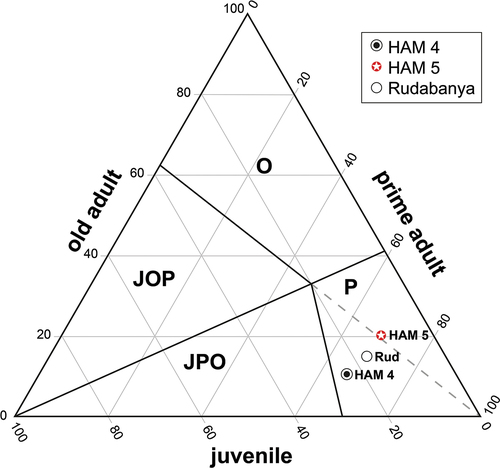Figures & data
Figure 1. Morphological nomenclature and the general tooth scheme of left lower (A) and right upper (B) cheek teeth (premolars and molars) used for the descriptions and comparisons of the minute beaver Euroxenomys minutus (von Meyer Citation1838), from the early Late Miocene locality Hammerschmiede (Bavaria, Germany). (A1) and (B1), occlusal views of early wear stages; (A2) and (B2), occlusal views of later wear stages; (A3) and (B4), lingual views; (A4) and (B3), buccal views. Enamel in white, dentine in dark grey, roots in light grey. Line drawings are not based on actual specimens and are not to scale. Nomenclature follows Stirton (Citation1935) and Hugueney (Citation1999).
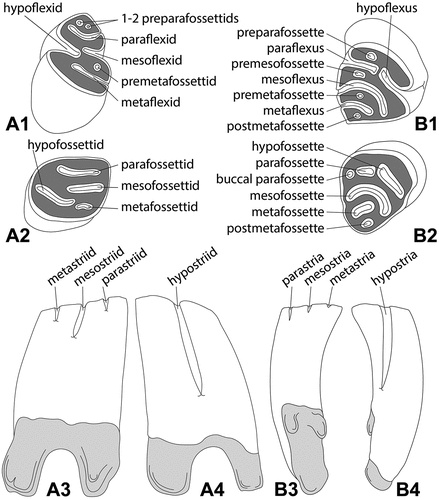
Figure 2. Cranial fragments of the minute beaver Euroxenomys minutus (von Meyer Citation1838), from the early Late Miocene locality Hammerschmiede (Bavaria, Germany), local stratigraphic level HAM 4. (A) SNSB-BSPG 2020 XCIV-9124, maxillae and fragmentary palatine with left P4 and right P4-M1 in left buccal (A1), mesial (A2) and occlusal (A3) views. (B) SNSB-BSPG 2020 XCIV-9523, maxillae and fragmentary palatine without dentition but with preserved alveoli of left P4-M3 and right P4-M2 in dorsal (B1) and occlusal (B2) views. (C) SNSB-BSPG 2020 XCIV-9522, right maxilla and fragmentary palatine with right P4-M2 in occlusal (c1) and right buccal (C2) views. Scale bar equals 10 mm.
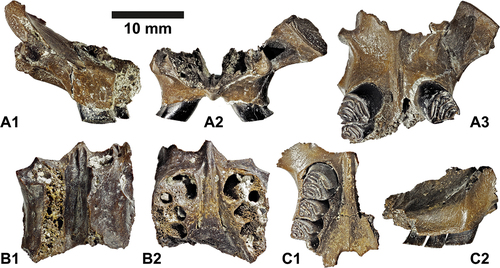
Figure 3. Upper cheek teeth of the minute beaver Euroxenomys minutus (von Meyer Citation1838), from the early Late Miocene locality Hammerschmiede (Bavaria, Germany), local stratigraphic levels HAM 5 and HAM 4. Deciduous premolars: (A-C); premolars (D-G); molars (H-P). Occlusal (A, B, C1, D1, E, F, G, H1, I1, K, L, M1, N1, O, P1), lingual (D3, H2, I3, M2, N2, P3), buccal (D2, I2, N3) and apical (P2) views. Scale bar equals 10 mm. Left DP4: (A) GPIT/MA/12001; (C) GPIT/MA/12058. Right DP4: (B) GPIT/MA/19158. Left P4: (G) GPIT/MA/18783. Right P4: (D) GPIT/MA/19060; (E) GPIT/MA/18780; (F) GPIT/MA/18835. Right M1/2: (H) GPIT/MA/18866; (I) GPIT/MA/18872; (K) SNSB-BSPG 2020 XCIV-6959; (L) GPIT/MA/19131. Left M3: (N) GPIT/MA/19088; (P) GPIT/MA/19127. Right M3: (M) SNSB-BSPG 2020 XCIV-6949; (O) SNSB-BSPG 2020 XCIV-2170.
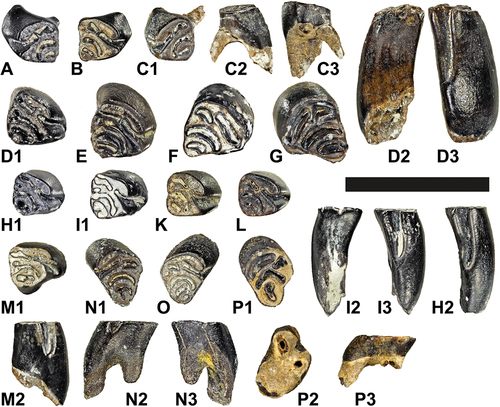
Figure 4. Mandibles of the minute beaver Euroxenomys minutus (von Meyer Citation1838), from the early Late Miocene locality Hammerschmiede (Bavaria, Germany), local stratigraphic levels HAM 5 and HAM 4. Scale bar equals 10 mm. (A) GPIT/MA/12168, right mandible with angular process, part of the coronoid process, i2, p4-m2 in buccal (A1), lingual (A2) and occlusal (A3) views. (B) GPIT/MA/17127, right mandible with i2 in buccal view. (C) GPIT/MA/16523, left mandible with broken i2 and complete cheek toothrow p4-m3 in lingual (C1), buccal (C2) and occlusal (C3) views. (D) SNSB-BSPG 2020 XCIV-5287, left mandible fragment with complete cheek toothrow p4-m3 in occlusal (D1) and buccal (D2) views.
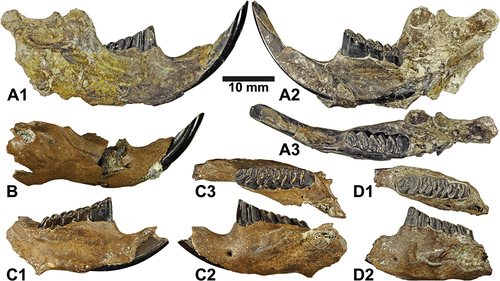
Figure 5. Lower cheek teeth of the minute beaver Euroxenomys minutus (von Meyer Citation1838), from the early Late Miocene locality Hammerschmiede (Bavaria, Germany), local stratigraphic levels HAM 5 and HAM 4. Deciduous premolars: (A-E); premolars (F-M); molars (N-X). Occlusal (A, B, C, D, E1, F G1, H, I1, K, L, M1, N1, O, P, Q1, R1, S1, T1, U1, V1, W, X1), lingual (E3, G3, I4, N2, Q2, R3, S2, T3, U2, V2, X4), buccal (E2, G2, I2, M2, N3, Q3, R2, S3, T2, U3, V3, X3), mesial (I3) and apical (X2) views. Scale bar equals 10 mm. Left dp4: (C) GPIT/MA/11999. Right dp4: (A) GPIT/MA/19166; (B) GPIT/MA/19095; (D) GPIT/MA/19093; (E) GPIT/MA/18988. Left p4: (H) GPIT/MA/18699; (L) SNSB-BSPG 2020 XCIV-6894. Right p4: (F) GPIT/MA/18678; (G) SNSB-BSPG 2020 XCIV-6889; (I) GPIT/MA/18732; (K) GPIT/MA/18676; (M) GPIT/MA/18725. Left m1/2: (N) GPIT/MA/19150; (Q) GPIT/MA/18964; (S) GPIT/MA/19021. Right m1/2: (O) GPIT/MA/19023; (P) GPIT/MA/19019; (R) SNSB-BSPG 2020 XCIV-7037. Left m3: (U) GPIT/MA/18982; (V) SNSB-BSPG 2020 XCIV-6983. Right m3: (T) SNSB-BSPG 2020 XCIV-6985; (W) GPIT/MA/19086; (X) GPIT/MA/19122.

Figure 6. Length/width dimensions of upper premolars of the minute beaver Euroxenomys minutus (von Meyer Citation1838), from the early Late Miocene locality Hammerschmiede (Bavaria, Germany), local stratigraphic levels HAM 5 and HAM 4, compared to Euroxenomys material from other Eurasian Miocene localities. Measurements for Hammerschmiede (HAM), Rudabánya and Dorn-Dürkheim additionally distinguish occlusal and basal tooth measurements while the other sites only include occlusal values. Data for Rudabánya from L. Kordos personal communication, for Dorn-Dürkheim own measurements, for Sansan from Hugueney and Duranthon (Citation2012), for Höwenegg from Giersch et al. (Citation2010), for Petersbuch 50 from Stefen and Rummel (Citation2003), for Anwil from Engesser (Citation1972), for Gratkorn from Prieto et al. (Citation2014), for Tagay from Mörs et al. (Citation2022), for Atzelsdorf from Daxner-Höck and Bernor (Citation2009) and for Felsötárkány from Hír (Citation2004)
Figure 7. Length/width dimensions of lower premolars of the minute beaver Euroxenomys minutus (von Meyer Citation1838), from the early Late Miocene locality Hammerschmiede (Bavaria, Germany), local stratigraphic levels HAM 5 and HAM 4, compared to Euroxenomys material from other Eurasian Miocene localities. Measurements for Hammerschmiede (HAM), Rudabánya and Dorn-Dürkheim additionally distinguish occlusal and basal tooth measurements while the other sites only include occlusal values. Data for Rudabánya from L. Kordos personal communication, for Dorn-Dürkheim own measurements, for Sansan and Elgg from Hugueney and Duranthon (Citation2012), for Höwenegg from Giersch et al. (Citation2010), for Petersbuch 50 from Stefen and Rummel (Citation2003), for Anwil from Engesser (Citation1972), for Gratkorn from Prieto et al. (Citation2014), for Tagay from Mörs et al. (Citation2022), for Atzelsdorf from Daxner-Höck and Bernor (Citation2009) and for Felsötárkány from Hír (Citation2004)
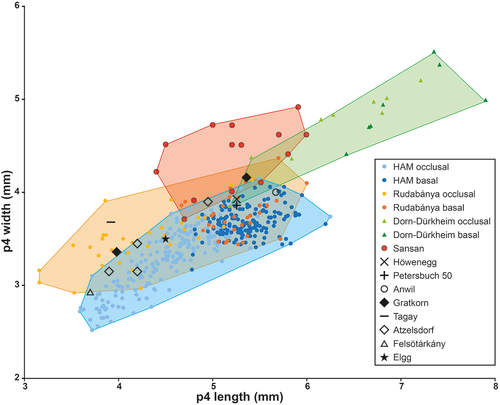
Table 1. Dimensions of upper and lower teeth of the minute beaver Euroxenomys minutus (von Meyer Citation1838), from the early Late Miocene locality Hammerschmiede (Bavaria, Germany), with combined treatment of the material from the local stratigraphic levels HAM 5 and HAM 4. L, mesio-distal length at occlusal surface and at basal crown position (where possible) for cheek teeth and length across anterior enamel band for incisors; W, bucco-lingual width at occlusal surface and at basal crown position (where possible) for cheek teeth; m, measurement; n, number of measurements (sum of occlusal and basal values); All measurements in mm.
Figure 8. Signs of digestive corrosion on dental material of the minute beaver Euroxenomys minutus (von Meyer Citation1838), from the early Late Miocene locality Hammerschmiede (Bavaria, Germany), local stratigraphic levels HAM 5 and HAM 4. (a) SNSB-BSPG 2020 XCIV-6917, left mandible with corrosion on p4 and m1 enamel in lingual (A1, A4), buccal (A2-A3) views and double magnifications of the corroded enamel regions (A3, A4). (B) GPIT/MA/19190, left lower incisor i2 with corrosion on enamel regions in labial/anterior (B1) and mesial (B2) views. Enamel of the tooth tip region is already completely missing while the proximal half preserves some portions of enamel. (C) GPIT/MA/17703, left mandible with broken i2 and cheek teeth p4-m2 with corrosion of the tooth enamel at the i2 and at the base of the molars in buccal (C1-C3) and double magnified (C2-C3) views. (D) GPIT/MA/19188, left lower incisor i2 without corrosion effects for comparison purposes with the corroded incisors in buccal (D1) and labial/anterior (D2) views. (E) SNSB-BSPG 2020 XCIV-0607, upper right incisor I2 in buccal (E1) and labial/anterior (E2) views, with signs of dental enamel corrosion that possibly amplify the incremental rhythm of growth lines. Scale bar equals 10 mm except for magnifications A3, A4, C2 and C3 where it corresponds to 5 mm.

Figure 9. Mortality profiles (age-frequency distribution) of the minute beaver Euroxenomys minutus (von Meyer Citation1838), from the early Late Miocene locality Hammerschmiede (Bavaria, Germany), based on lower premolars from the local stratigraphic levels HAM 5 and HAM 4. Each bar corresponds to an age class, defined by either morphologic criteria (WS 1-WS 2) or mathemathical spread of the tooth crown height (WS 3-WS 6) as defined in the materials and methods section. Vertical axis represents the percentage of individuals within the corresponding local stratigraphic level.
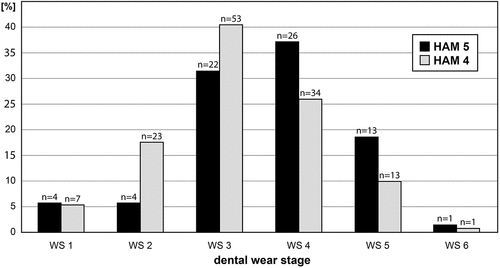
Figure 10. Ternary diagram of the relative age-frequency distributions (mortality) differentiated into the three age groups juvenile, prime adult and old adult individuals (in %) of the small beaver species Euroxenomys minutus (von Meyer Citation1838) from the early Late Miocene localities Hammerschmiede (Bavaria, Germany), including the local stratigraphic levels HAM 5 and HAM 4 and from Rudabánya (Hungary; Data from Kordos Citation2020) based on lower premolars. Calibration of the zoning point corresponds to the relative lifetime distribution of the extant muskrat, Ondatra zibethicus (see text). Abbreviations of zones follow Discamps and Costamagno (Citation2015): JOP, juveniles-old adults-prime adults dominated zone; JPO, juveniles-prime adults-old adults dominated zone; O, old adults dominated zone; P, prime adults dominated zone. All three fossil samples are located in the prime dominated zone.
